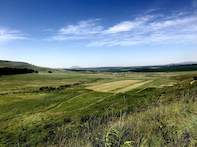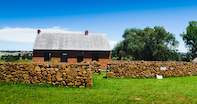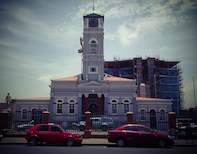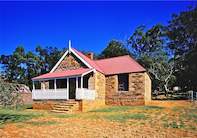Historic Battlefields
Newcastle is a good base to explore the historic battlefields of the Anglo-Boer Wars and a few sites in town bear testimony to these important events in South African history.

Newcastle is known for the British defeat at Majuba (the hill of doves) which was the effective end of the First Anglo-Boer War. From the top of the hill 400 British troops, unsupported by artillery, looked down as an equal number of Boers rode up, dismounted and slowly climbed to their position.
Stand at the top and imagine the shock of the scarlet uniformed Brits as an undisciplined but highly lethal group of farmers overran their position, shouting “Remember Majuba!”
Fort Amiel

During the 1870’s, an armoury was built in Newcastle when a threat of war against Zululand emerged. The Armoury provided a home and meeting point for local volunteers and those in service. British politician and army officer Winston Churchill himself spent the night at Newcastle Armoury as a prisoner of the Boer forces in 1899. The building is open to the public to view the military memorabilia.
The Fort Amiel Museum is set in Newcastle and was formerly a fort, built in 1876 by the 80th Staffordshire Volunteers and Major Amiel as a lookout post for British soldiers leading up to the Zulu War. The fort was used as a garrison for the King's Royal Regiment during the Boer War and also served as a hospital, transit camp and depot.
In 1979 the fort, surrounding area and graveyard was declared a national monument and restoration on the site began after they found the original plans for the fort in the London Museum. Fort Amiel is now a historical and cultural museum that exhibits the two Anglo-Boer Wars, a reconstruction of the British Army Base and a vast collection of items used during this time.
Newcastle Town Hall

The Newcastle Town Hall was built in 1897 in honour of Queen Victoria’s Diamond Jubilee. Once it was completed in 1899, a collection was started to add a clock to the building.
The Town Hall has been part of many historical events including the second Boer War, where it was used to store furniture that was pillaged during this time. Now a national monument, Newcastle Town Hall has been fully restored and holds various concerts.
Monuments have been erected outside the Town Hall in remembrance of brave men who gave their lives during the Anglo-Zulu War. This fascinating building is brimming with history and makes for an interesting visit.
Newcastle Monuments and Memorials

Hilldrop House
Once the home of author Rider Haggard, whose novel Jess, published in 1887, was based on his experiences at Hilldrop House. The peace treaty that ended the First War of independence was signed in this house on the 23 March 1881. Now a national monument, the house is a private residence and arrangements to visit should be made through Tourism Newcastle..
O'Neills Cottage
Situated at the foot of the Majuba Mountain is a quaint stone cottage. This cottage, the original home of Eugene O'Neil, was used as a makeshift hospital for British soldiers during the Battle of Majuba and many of their graves are here. The peace treaty that was signed to end the First War of Independence was signed in this area. The turnoff to this cottage is on the N11, in Laing's Nek pass, between Volksrust and Newcastle.
St Dominic's Pavilion
A national monument, this elegant building dating from 1916 was designed as a skating rink and used for social events. Situated at St Dominic's Academy, previously a Catholic Convent. Tourism Newcastle.